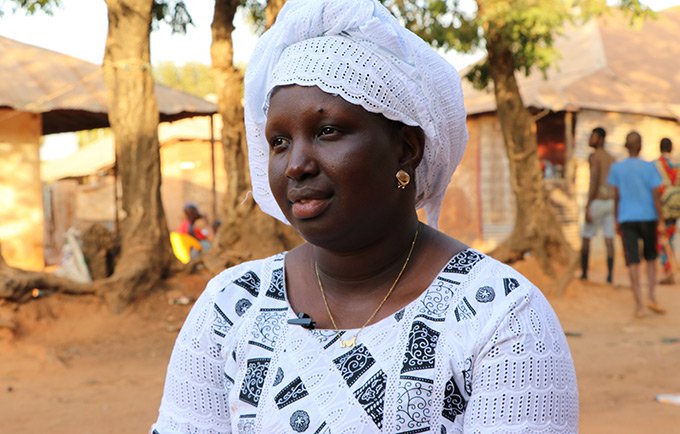A demonstration of male and female condoms. ©Ollivier Girard
What is comprehensive sexuality education?
Comprehensive sexuality education is a rights-based and gender-focused approach to sexuality education, whether in school or out of school. It is taught over several years, providing age-appropriate information consistent with the evolving capacities of young people.
Comprehensive sexuality education includes scientifically accurate information about human development, anatomy and reproductive health, as well as information about contraception, childbirth and sexually transmitted infections (STIs), including HIV.
But it also goes beyond information, helping young people to explore and nurture positive values regarding their sexual and reproductive health. This education includes discussions about family life, relationships, culture and gender roles, and also addresses human rights, gender equality, and threats such as discrimination and sexual abuse.
Taken together, these programmes help young people develop self-esteem and life skills that encourage critical thinking, clear communication, responsible decision-making and respectful behaviour.
According to
Comprehensive Sexuality Education: Advancing Human Rights, Gender Equality and Improved Sexual and Reproductive Health, comprehensive sexuality education must do the following:
• Foster respect for human rights and diversity
• Encourage critical thinking skills and young people’s participation in decision-making
• Nurture attitudes that promote gender equality and inclusion
• Adapt to suit the age, culture and needs of young people
• Communicate a positive, life-cycle approach to sexuality
• Contain scientifically accurate information
• Offer a safe and healthy learning environment
• Include participatory teaching methods to help strengthen communication skills and decision-making abilities
• Address gender inequality, vulnerabilities, exclusion and human rights violations, including gender-based violence and sexual abuse
This education may go by other names, such as “life skills,” “family life,” or “HIV” education. Sometimes it is called “holistic sexuality education.” These names may imply differences in emphasis. For example, life skills education may include a focus on caring for sick family members, coping with loss or other similar issues.
A matter of human rights
The sexual and reproductive choices of young people can have a cascading effect on their human rights. Adolescent pregnancy, for example, can lead girls to drop out of school, which deprives them of their right to education. Poor understanding of gender equality can lead to discrimination.
Comprehensive sexuality education empowers young people to know and demand their rights. The importance of sexuality education has been recognized by numerous international agreements.
The rights to education and health are also embedded in many international agreements, including the Programme of Action of the 1994 International Conference on Population and Development and the Convention on the Rights of the Child.
Key facts
1. Comprehensive sexuality education does not lead to earlier sexual activity or riskier sexual behaviour.
2. In fact, these programmes reduce risky behaviours: About two thirds of evaluations show reductions in targeted risky behaviours. About 60 per cent of programmes had a positive effect on at least one behavioural or biological outcome, such as increased condom use or reduced unplanned pregnancies.
3. Studies of abstinence-only programmes are either inconclusive or show abstinence-only education to be ineffective.
4. Delivering high-quality comprehensive sexuality education requires training and support.
5. Addressing gender and power issues also leads to better health outcomes.
6. To be most effective, curricula must be tailored to the specific context and needs of young people
7. Engaging parents and communities as part of this education is critical.
What is UNFPA doing?
UNFPA works with governments and partners to develop and implement comprehensive sexuality education programmes that meet international technical standards. UNFPA also advocates for policies on, and investments in, comprehensive sexuality education, both in and out of schools.
Out-of-school programmes include community-based training and education, often aimed at the young people most in need of information – such as married adolescent girls, homeless youth, migrants and refugees, youth in remote rural areas, and those living in conflict zones. In many countries without in-school sexuality education, UNFPA supports the Y-PEER programme, a peer-to-peer youth network that uses a combination of experiential learning methods, ‘edutainment’, social media and new technologies to convey health information to young people.
There has been great progress in making comprehensive sexuality education available around the world.
In 2013 in Eastern and Southern Africa, for instance, health and education ministers from 20 countries committed to increase access and quality to these programmes. Their target is to offer comprehensive sexuality curricula in 90 per cent of schools by 2020.
And the Safeguard Young People programme in Botswana, Lesotho, Malawi, Namibia, Swaziland, South Africa, Zambia and Zimbabwe is also providing comprehensive sexuality education both in schools and in community settings. Safeguard Young People also offers youth-friendly health services, youth empowerment activities, skills building and other support. In the past two years, Safeguard Young People has reached over 4.39 million young people.
Updated 30 September 2016.










